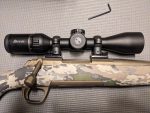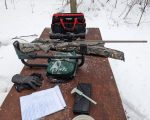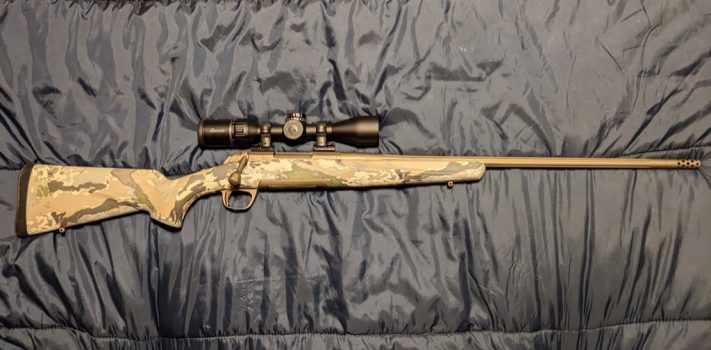Back in February, I tested Browning’s X-Bolt Speed bolt-action rifle chambered in 6.5 Creedmoor. I found it to be light and well-balanced with outstanding fit and finish, moderate recoil, a great trigger, and excellent accuracy.
The X-Bolt Speed is not the most inexpensive bolt action rifle on the market, with a manufacturer suggested retail price of $1,379.99 . Due to the high quality of its materials and workmanship, this price represents a good value for the money.
Background
As I have aged, I have become gradually more sensitive to recoil. This recoil aversion has motivated me to test some potential deer rifles that kick less than the Remington 742 in 30-06 that I inherited from my Father. The possibility of more moderate recoil combined with improved long-range accuracy made rifles chambered in 6.5 Creedmoor especially intriguing.
I consulted with Browning about their rifles chambered in 6.5 Creedmoor. They offered to let me test an X-Bolt Speed chambered in that cartridge. I gratefully accepted their kind offer. A few days later, the rifle arrived at my FFL.
First Impressions
The box that I picked up at my FFL contained the rifle, bolt, security lock, a thread protector (to replace the muzzle brake, if removed), the manual, a purchase confirmation card, an NRA ad, an NSSF safety brochure, and an ad for browning.com. One additional item that I would recommend including in the box is a set of bases for a scope. Since the rifle does not have iron sights, these bases are essential for the successful operation of the rifle. The end user is unlikely to have them on hand since, unlike many other optics components, these bases are not interchangeable with other rifle models.
Information stamped into the barrel of the rifle indicates that it is manufactured by Miroku in Japan. It has a 22-inch, free-floated, fluted barrel with a radial muzzle brake and an 1-in-8-inch rifling twist rate. The external metal parts have a smoked bronze Cerakote finish. The synthetic stock is finished with a Browning “OVIX” camo pattern. The “Inflex II” recoil pad is designed to help direct recoil energy down and away from the face.
Fit and finish are exceptional, with excellent workmanship done to close tolerances with no extraneous tool marks or blemishes.
The excellent trigger consistently breaks crisply and smoothly. The trigger can be adjusted from roughly 3 to 5 pounds. It is preset at the factory to about 4 pounds. This felt about right to me, so I did not change the setting during the course of my testing. The gold finish on the trigger is a nice bonus.
The removable 4 round box magazine seems sturdy, fits flush with the bottom of the stock, and is easy to remove and insert.
The bolt operates as smoothly as butter and has a lift of 60 degrees. There is a bolt unlock button on the bolt, which allows the bolt to be cycled while the tang safety on the comb of the stock is in the “safe” position. I found this arrangement to be quite practical during the course of my testing.
The rifle is 42 inches overall, and weighs in at just 6 pounds, 5 ounces.
Reading the Manual
Reading the manual of a new rifle is not typically exciting, but I recommend it anyway. This particular manual is 44 pages long, counting the front and back covers. It begins with the basic rules of safe firearms handling. Browning was wise to present this information early, while the reader is still paying attention.
The manual advises cleaning the rifle before first use in order to remove the rust-preventative compound with which it was shipped. The use of this compound explains why the rifle did not arrive excessively oily, like so many firearms do.
Field stripping involves removing only the bolt and magazine. Further disassembly is not recommended. As a result, there are no directions for disassembling and cleaning the bolt or the trigger group.
The legally-mandated, state-by-state warnings came at the end of the manual. This is also appropriate, since those warnings are guaranteed to cause the reader’s eyes to glaze over.
First Cleaning
I cleaned the rifle as recommended in the manual in order to remove the rust-preventative compound from the barrel and action. I began by removing the bolt and cleaning the bore from the breech using patches with kerosene as a solvent. When the patches came through clean, I used a dry patch to remove excess solvent from the bore. I then used the same solvent/dry patch cleaning pattern on the bolt, action, and external metal parts. I finished by applying a light film of CLP to all accessible metal surfaces.
Installing the Scope
 I began the scope installation process by mounting Browning Weaver-style Scope Bases on the rifle. I had ordered these bases separately, after discovering that the rifle did not come supplied with bases. Next I installed a set of medium Burris 1″ Weaver-Style Signature Zee Rings on the bases. I then installed a Burris Signature HD 2-10X40mm scope in the rings. I did not feel that the bases and rings left much room for sliding the scope forward or backward in order to adjust the eye relief. But when I mounted the scope in the rings, I found that it fell exactly into the right place, so that the eye relief did not need any adjustment.
I began the scope installation process by mounting Browning Weaver-style Scope Bases on the rifle. I had ordered these bases separately, after discovering that the rifle did not come supplied with bases. Next I installed a set of medium Burris 1″ Weaver-Style Signature Zee Rings on the bases. I then installed a Burris Signature HD 2-10X40mm scope in the rings. I did not feel that the bases and rings left much room for sliding the scope forward or backward in order to adjust the eye relief. But when I mounted the scope in the rings, I found that it fell exactly into the right place, so that the eye relief did not need any adjustment.
I then leveled the scope and focused the reticle. I believed at the time that I had tightened the rings adequately, but I was apparently too cautious in the amount of torque that I applied.
The First Range Session
I put on insulated canvas coveralls and a jeep cap, grabbed the rifle and some ammo, and headed to the improvised range behind my pole barn.
I set up some targets by the backstop, and set up a table 25 yards away. I put a lead sled on the table, put the rifle in the Lead Sled, removed the bolt, and bore-sighted the rifle.
Next, I loaded a single round of Sellier & Bellot 149 grain SP. The bolt consistently operated very smoothly. I was pleased when the first round was not only on paper, but within two inches of the center of the target.
 My initial pleasure turned to frustration as I struggled with the scope over the course of the next seven rounds or so. This was due to user error on my part, since I had not tightened the rings quite enough when I mounted the scope. Under recoil, the scope shifted in the rings, throwing off my zero. Eventually the recoil jammed the scope as far forward as the rings would allow, and the zero became consistent.
My initial pleasure turned to frustration as I struggled with the scope over the course of the next seven rounds or so. This was due to user error on my part, since I had not tightened the rings quite enough when I mounted the scope. Under recoil, the scope shifted in the rings, throwing off my zero. Eventually the recoil jammed the scope as far forward as the rings would allow, and the zero became consistent.
Once the zero became consistent, I fired a number of three shot groups with several different types of ammo. The rifle did quite well with Sellier & Bellot 140 grain SP and Winchester 129 grain Power Point ammunition. It was not at all accurate with Aguila 140 grain FMJBT ammo.
Throughout the range session, I found the muzzle brake to be very loud. Even though I wore hearing protection, the noise from the brake was loud enough to leave my ears ringing.
 During the course of the range session, it began to snow. As it began to snow harder, a significant amount of snow accumulated and melted on the rifle. This increased my appreciation for the synthetic stock and the corrosion-resistant Cerekote finish on the metal parts. It also encouraged me to wipe off the excess moisture with a rag, and then clean the rifle immediately following the range session.
During the course of the range session, it began to snow. As it began to snow harder, a significant amount of snow accumulated and melted on the rifle. This increased my appreciation for the synthetic stock and the corrosion-resistant Cerekote finish on the metal parts. It also encouraged me to wipe off the excess moisture with a rag, and then clean the rifle immediately following the range session.
The Second Range Session
The second range session was at the 100-yard indoor range of the local rod and gun club. Since the muzzle brake had produced so much noise at my outdoor range, I decided to remove it and replace it with the thread protector prior to firing the rifle indoors. I was glad that I did. Felt recoil remained very moderate, and the noise reduction was significant.
Ammo performance at the indoor range was consistent with the preliminary results at the outdoor range. The rifle produced decent groups using the Sellier & Bellot and Winchester ammunitions, ranging from 1.08 to 1.45 MOA. These are very good groups for me, since I am not the greatest bench rest shooter in the world. In contrast, the one group I shot with the Aguila ammo was 4.2 inches.
Conclusions
I was very pleased with the Browning X-Bolt Speed in 6.5 Creedmore. It is accurate, lightweight, attractive, well-balanced, and weather-resistant with moderate recoil. A good selection of ammo in 6.5 Creedmoor is currently available at local retailers and online. This rifle is an excellent choice in the $1,000 to $1,500 price range.
The only improvement that I could suggest would be to include a set of scope bases in the box.
Disclaimer
Browning was kind enough to loan me an X-Bolt Speed in 6.5 Creedmoor for testing and evaluation. Burris loaned me their Signature HD 2-10X40mm scope and 1″ Signature Medium Zee Rings. I tried not to let their kindness influence my objectivity, and believe that I have succeeded. I did not receive any other financial or other inducement to mention any vendor, product, or service in this article.










